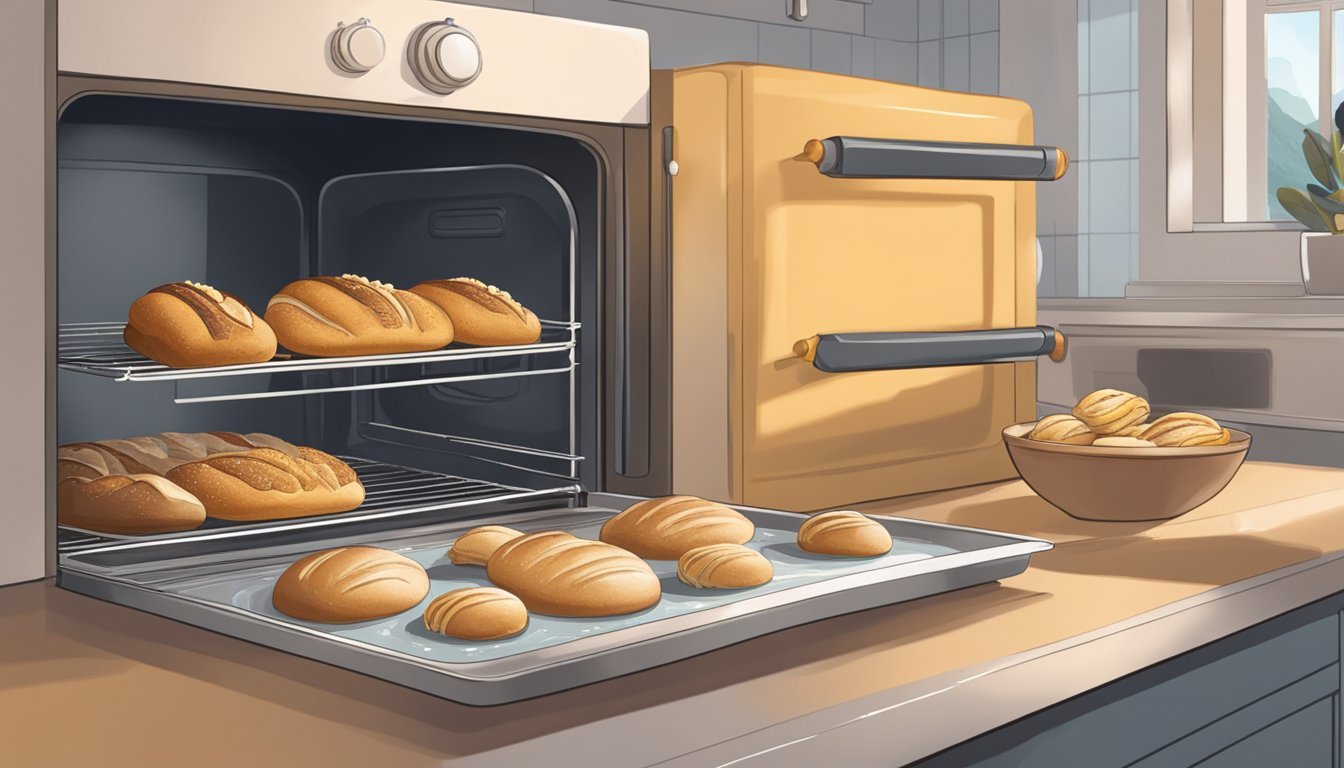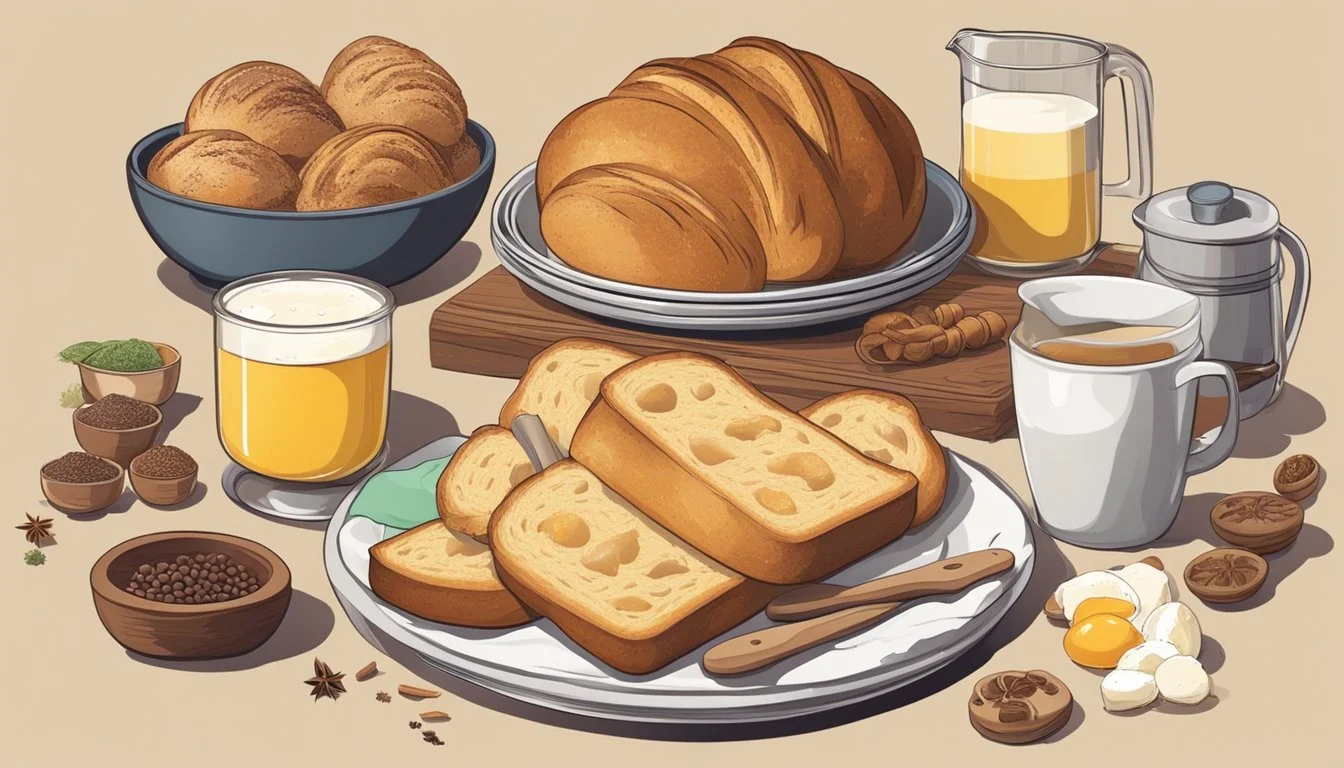How to Revive Stale Bread and Pastries
Simple Restoration Techniques
Reviving stale bread (What wine goes well with bread?) transforms what could be wasted into enjoyable, fresh-tasting food. Whether one has a loaf that has lost its softness or pastries that aren't at their peak, there are reliable methods to restore their former glory. The process involves reintroducing moisture and heat to rebalance the bread's internal structure, turning a once-tough texture into a palatable one.
Bread goes stale due to the crystallization of starches that occur over time, making it hard and dry. To counteract this, one can utilize the oven or microwave in different ways to reintroduce moisture. Each technique, whether employing steam or direct moisture application, ensures the bread regains a desirable texture.
Pastries, with their varying ingredients and structures, also suffer from staleness but can be rejuvenated with careful reheating. The goal is to achieve a balance where the exterior is crisp and the interior is soft, ensuring that the pastries are as close as possible to their freshly baked state. With a bit of heat and the right approach, even day-old pastries can delight the palate once again.
Understanding Stale Bread
In the journey from fresh to stale, bread undergoes physical and chemical changes. Recognizing the distinction between stale and spoiled bread is crucial for safe consumption and potential revival.
What Makes Bread Go Stale
Bread stales primarily because of a process known as retrogradation, where the starch molecules in the bread begin to re-crystallize. This occurs most rapidly at temperatures just above freezing, which is why storing bread in a refrigerator can actually make it go stale faster. The ideal conditions for keeping bread fresh are at room temperature in a dry environment, tightly sealed to keep out air which can speed up the staling process.
Differences Between Stale and Spoiled Bread
It's important to distinguish stale bread from spoiled bread:
Stale Bread: Still safe to eat, but has a hard texture and lacks the fresh taste.
Spoiled Bread: Can manifest mold or an off odor, indicating that it's no longer safe to consume.
Stale bread hasn't begun to rot, but rather has lost moisture and undergone starch retrogradation, making it firm and dry. Spoiled bread, on the other hand, will have signs of bacterial or fungal growth, and should be discarded to avoid health risks.
Reviving Techniques
Reviving stale bread and pastries can be effectively achieved through several techniques, employing the use of an oven, steam, or microwave to restore freshness and improve texture.
Using the Oven to Restore Freshness
For heating evenly and revitalizing the crust, the oven is often the preferred method. One begins by preheating the oven to 300-325 degrees Fahrenheit. The bread should be placed directly on the rack for 6-7 minutes, or for a particularly moist loaf, 10-12 minutes could be necessary. For pastries, wrapping in aluminum foil before placing them in the oven can prevent them from drying out, ideally being reheated for approximately 15 minutes.
Steaming Bread Back to Life
Steaming introduces moisture back into the bread, softening the inside while keeping the crust crisp. This can be done by moistening the outer crust of the bread with water, then heating it in the oven. As an alternative, one can heat a pot of water to produce steam and place the stale bread inside for a few minutes. This technique allows the bread to absorb moisture directly from the steam.
Microwave Method for Quick Revival
For a rapid method, the microwave can be used, especially when time is of the essence. By wrapping the bread or pastry in a damp paper towel and microwaving it on a plate for 10 seconds, it can quickly become more palatable. However, this method may not restore the original texture as effectively as the oven or steaming methods, and is better suited for bread that has only recently become stale.
Preventive Measures
To ensure that bread retains its fresh-baked quality, proper storage is essential. These preventive measures can markedly extend the life of bread and pastries.
Properly Storing Fresh Bread
Securing fresh bread in a cool, dry place can dramatically affect its longevity. Unsliced loaves should be kept in a bread box or wrapped in a breathable material like a cotton bread bag or a clean kitchen towel. It's key to maintain the right humidity level to prevent staleness and mold growth. For those who buy in bulk or enjoy homemade bread recipes, freezing becomes a viable option. To freeze, one should first slice the bread (to facilitate easy thawing), wrap it in plastic wrap, and then place it in a heavy-duty freezer bag.
Refrigerator vs. Counter: Where to Keep Your Bread
The fridge can seem like an intuitive option for preservation, but it actually accelerates staling due to the cold temperatures causing retrogradation of the starches in the bread. Therefore, bread should be kept at room temperature on the counter for up to a couple of days. The counter method preserves the bread’s texture and taste. Only resort to the fridge if the climate is extremely humid and hot, and even then, this should be a short-term solution.
Repurposing Stale Bread
Reviving stale bread doesn't just mean refreshing it to its former glory. One can transform day-old bread into an array of delightful dishes that serve as both key ingredients and standalone favorites.
Croutons: A Crunchy Salad Topper
To make croutons, one needs to cube the stale bread and toss it with olive oil, herbs, and seasoning. After spreading the cubes on a baking sheet:
Oven temperature: 375°F (190°C)
Baking time: 10 to 15 minutes
They should be golden brown and crispy.
They elevate salads and soups with their texture and flavor.
Creating Breadcrumbs for Cooking
Breadcrumbs are simple to make and highly versatile in the kitchen. The bread should be:
Oven-dried until completely hard.
Cooled.
Ground to the desired coarseness.
They work perfectly for coating meats, thickening sauces, or as a crunchy topping for baked dishes.
Bread Pudding: A Sweet Solution
Bread pudding repurposes stale bread into a delicious dessert. Mix chunks of bread with:
A custard base of eggs, milk, sugar, and vanilla.
Optional: raisins, nuts, or chocolate chips.
Bake at 350°F (175°C) until set and golden, which usually takes about 40-45 minutes.
Classic French Toast
French toast is a breakfast classic and a fantastic way to use day-old bread. Dip slices of bread in a mixture of:
Beaten eggs
Milk
A hint of cinnamon and vanilla
Cook on a griddle or frying pan until each side is golden brown. Serve with syrup or fruit for added indulgence.
Savory Recipes: Ribollita and More
Ribollita is a hearty Tuscan soup that becomes more flavorful with the addition of stale bread. The bread thickens the soup, and along with cannellini beans, kale, and other vegetables, it creates a comforting dish. Other savory recipes include:
Bread-based stuffing
Panzanella, an Italian bread salad
Stratas, layered casserole dishes
Stale bread should never be wasted—as it serves as an essential component in these diverse, appetizing recipes.
Advanced Tips and Tricks
In the realm of bread revival, certain advanced techniques can transform stale bread back to a pleasing texture. The following methods employ careful manipulation of moisture and heat to ensure optimal softness and restoration.
Rehydrating Bread Under Water
To rehydrate crusty bread like baguettes or sourdough, one can run them briefly under running water. Saturate the exterior of the bread without oversoaking to avoid a gummy texture. It's ideal to revive unsliced loaves using this method, as they retain their structure better during the process.
Bread Type Water Temperature Duration Under Water Crusty Baguettes Lukewarm 5-10 Seconds Dense Sourdough Cold 10-15 Seconds Soft Bread Lukewarm 5 Seconds
Mastering the Bread Hack
The bread hack involves wrapping the moistened loaf in aluminum foil, creating a steam chamber when placed in the oven. Preheat the oven to 300-350°F (150-175°C), then heat the bread for approximately 10-15 minutes. This allows the exterior to crisp up, while the steam softens the interior, reviving the loaf to a near-new state.
Fluffy Interior: Softening Techniques
For a fluffy interior, especially with softer loaves, a gentler approach is warranted. Lightly dampen the bread with a spray bottle—this simulates the effect of rehydrate without oversaturation. Place the bread in a preheated oven at a low temperature, covered in foil for even, gentle warming. This technique best restores the bread's original soft and fluffy qualities.
By applying these techniques with precision, stale bread can often be revitalized effectively, keeping waste to a minimum and enjoyment at a maximum.
Beyond Bread: Pastry Revival
Reviving pastries, much like bread, relies on the careful application of heat to restore texture and flavor. The process is delicate due to the varied ingredients, like butter, which can react differently when reheated.
Reviving Stale Pastries
To revive a pastry, the key is to reintroduce moisture and heat it just enough so that the butter within becomes tender but not greasy. The following steps can help:
Preheat the oven to 350°F (175°C). For small pastries, a toaster oven set at the same temperature can also be effective.
If the pastry is extremely dry, lightly brush it with water to reintroduce moisture. This works well for crustier pastries.
Place the pastry on a baking sheet lined with parchment paper to prevent sticking and ensure even reheating.
Heat the pastry for about 5-7 minutes. This time can vary depending on the size and type of pastry. Larger or denser pastries might need a bit more time.
Check the pastry periodically to ensure it does not burn or become too oily. Pastries with high butter content should be monitored closely as the butter can melt and cause the pastry to become soggy.
For pastries that are only slightly stale, a microwave might suffice:
Wrap the pastry in a paper towel to retain moisture.
Microwave on high for 10-15 seconds. Avoid overheating as this can melt the butter excessively and toughen the pastry.
The pastry should now be warm, with a rejuvenated texture closer to its original state. Enjoy promptly for best results.



